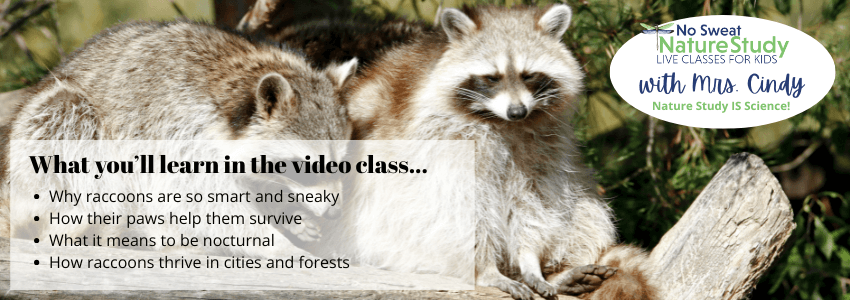What’s Making Noise Outside at Night? Nature Study for Kids
What’s that sound outside your window at night? A hoot, a rustle, maybe even a sneaky raccoon on the move? In this fun and mysterious No Sweat Nature Study Podcast episode, kids will discover which animals come alive after dark. It’s the perfect way to kick off our upcoming raccoon nature study video class, where we’ll explore the clever traits of those masked nighttime bandits.
Young scientists will learn what it means to be nocturnal and why so many animals choose the nighttime to hunt, hide, and hoot. Whether you’re preparing for a nature walk or staying cozy indoors, this short episode is a great way to spark curiosity and bring science to life.
Raccoon Nature Study
Use these questions to chat with your children after listening to the episode. They’re perfect for reviewing science concepts and sparking a fun discussion.
- What does it mean when an animal is nocturnal? (It means the animal sleeps during the day and is active at night.)
- Why is nighttime a safer time for some animals to be active? (Because it helps them avoid predators or lets them hunt more stealthily.)
- What are three special senses that help nocturnal animals survive in the dark? (Night vision, strong hearing, and a super sense of smell.)
- Which bird is known for its wide eyes and silent flight? (The owl.)
- What animal is described as having a “mask” and “busy paws”? (The raccoon.)
- Why might you hear more hooting from owls in late fall? (Because they are preparing for the courtship season.)
- What is happening with deer during rutting season? (Bucks are moving through the woods and competing for mates.)
- What are tiny rodents like mice and voles doing on chilly fall nights? (They are squeaking and scurrying to find cozy, warm spots.)
Raccoon Nature Study Video Class
Get ready to meet one of the cleverest night creatures around in the upcoming No Sweat Nature Study video class, all about raccoons. Students will explore the amazing adaptations that help raccoons thrive in both wild and urban environments, from their ringed tails and masked faces to their nimble paws and sharp problem-solving skills.
During class, kids will create a detailed nature journal page that highlights key raccoon features and behaviors. It’s a fun and educational way to combine science, observation, and art. If your family isn’t a member yet, visit NoSweatNatureStudy.com to join and enjoy this class along with 175+ others covering all sorts of fascinating science topics.

Free Nature Observation Printable Packet for All Seasons
The No Sweat Nature Study Podcast community has been sharing recommendations of excellent nature-themed books. Click here to find a compilation of listener favorites!
Would you like to record a voicemail to answer this season’s nature study question?
At the end of each No Sweat Nature Study Podcast episode, Mrs. Cindy includes messages from a few of her friends. You can record a message that she might use on an upcoming episode!
All children must have their parents’ permission before leaving a recording. Parents are welcome to record an answer, too!
Each season, there will be a different question to answer. You can see this season’s question below. Think about your answer first, and then follow these simple directions:
- Click the “Start recording” button.
- Tell me your first name. (If you want to tell your age and/or where you live, feel free to do that.)
- You will have 60 seconds to answer the question, but try to be concise.
- Push the play button to listen to your recording before sending it, to ensure it is recorded correctly. If not, record it again.
Please leave a rating or a review on your podcast app! It helps the podcast to show up for more people…which means more families can enjoy science through the wonderful lens of nature study! Thank you!
